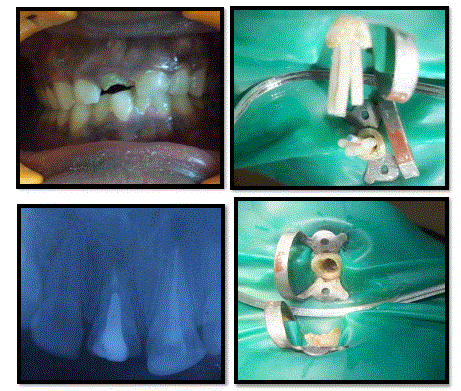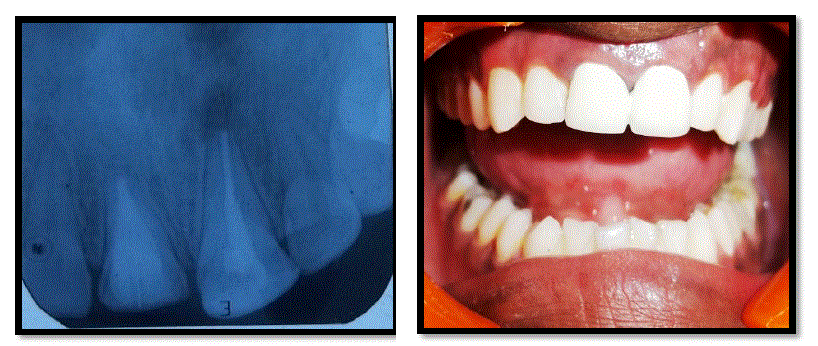ISSN ONLINE(2319-8753)PRINT(2347-6710)
ISSN ONLINE(2319-8753)PRINT(2347-6710)
Vipin Arora1, VineetaNikhil2, NavleenKaur Suri3, Pooja Arora4
|
| Related article at Pubmed, Scholar Google |
Visit for more related articles at International Journal of Innovative Research in Science, Engineering and Technology
This paper focuses on reinforcement and restoration of severely weakened teeth having wide flared canals with thin dentinal walls, which are at a high risk of fracture. Traditionally, such teeth would be restored using cast metal posts, but this procedure has often been unsuccessful, because of lack of resistance against root fracture. The case presented depicts a flared canal reinforced using a new innovative technique involving fiber posts along with auxillaryprepolymerizednanohybrid composite posts, rendering the weakened endodontically treated root capable of supporting a post and core, and thereby ensuring continued function of such badly damaged tooth.
Keywords |
| Auxillary, Fiber post, Flared root canal, Post and core, Reinforcement, Nanohybrid composite. |
I. INTRODUCTION |
| Roots can become weakened if flared as a result of recurrent caries into the root dentin, over preparation of the root canals, or the fact that the pulp has become necrotic prior to completion of root formation in a young patient. The flared root canals have thin dentin walls and are weak to withstand normal masticatory forces and hence susceptible to fractures, which makes the restorative procedure even more difficult [1-6]. |
| For many years, cast posts were used for the treatment of such teeth with wide canals without considering the quality and quantity of the remaining tooth tissue. These posts achieve a good fit to the canal walls but they potentially lead to its fracture because of great stiffness in homogeneity between metal and dentin [7-10]. |
| For these reasons, fiberposts have increased in popularity because of their favorable biomechanical properties and thus decreased incidence of root fractures [11]. Nevertheless, the fiber posts also could not match the root canal anatomy, especially in cases of excessively flared root canals.This results in a potentially weak area in the restoration, which may compromise the long-term prognosis [1-6]. In order to avoid this, reinforcement of the radicular space with restorative materials, such as a glass ionomer cement, composite resins etc is done along with fiber post. Recently, few authors have suggested the use of auxillary posts simultaneously applied with master fiber post to increase the adaptation of fiber post in cases of overflared canals to increase fracture resistance of teeth [12,13]. |
| Based on this premise, in the present case report a new and innovative technique utilizing prepolymerisednanohybrid composite (PNC) auxillary posts is presented for restoration of a maxillary central incisor with weakened and flared root canal. |
II. CASE REPORT |
| A 19 year old boy was referred to the postgraduate clinic of our department. The chief complaint was discolored and fractured upper front teeth. He met with an accident eight years back. He also told about root canal treatment of upper front teeth followed by placement of metallic pin and a crown which got dislodged two months after treatment. The patient’s medical history was noncontributory. |
| Clinical examination revealed a discolored and traumatized maxillary right central incisor with less than 1/3rd of the tooth structure present (Fig. 1A). A cast metal post with insufficient core was also reported. An intraoral periapical radiograph revealed endodontically treated 11 and 21with slight periodontal widening in relation to 11 and periapical rarefaction in 21(Fig. 1B). So, a treatment plan was made to remove this post and to re-restore the tooth with post and core after endodontic retreatment of 11 and 21.The patient denied for retreatment of 21and gave written consent for retreatment of 11 only. |
 |
| The cast post was removed using ultrasonics. The remaining guttapercha was also removed. It was noticed that secondary caries in root dentin was present in the post space (Fig. 2A). Caries was carefully removed with the help of an excavator. |
| Fig.2. A: Incisal view of the tooth after post and secondary caries removal, B: Try in of the fiber post and auxillary PNC posts before root reinforcement |
| An intraoral periapical radiograph revealed very thin dentin walls. The tooth was endodontically retreated and sectional obturation was done leaving 5 mm in apical third for the apical seal.A decision was made to place a fiber post along with reinforcement of root dentin. |
| A glass fiber post (Reforpost, Angelus) was tried in the prepared post space, but a lot of space was still present around the post. In order to reinforce the tooth in predictable manner, it was decided to place auxillary PNC posts. The nanohybrid composite(3M™ ESPE™ Filtek™ Z250 XT, U.S.A) was moulded in cyclindrical shape with a tapering design just like fiber post on a glass slab and then subsequently extended light curing was done from all sides for 160 seconds. The fiber post along with auxillary PNC posts were tried and adjusted in the canal (Fig. 2B). |
| The canal space was treated with NRC conditioner (Paracore, Coltene/ Whaledent AG 9450 Altstatten/ Switzerland) and cemented into the canal using bonding system( Paracore, Coltene/ Whaledent AG 9450 Altstatten/ Switzerland) and dual cure resin cement (Paracore, Coltene/ Whaledent AG 9450 Altstatten/ Switzerland). |
| Core build up was done using dual cure resin cement which was cured for 40 seconds for each increment (Fig. 3A). Next, both the central incisors were prepared to receive porcelain fused to metal crowns (Fig. 3B). |
 |
III. DISCUSSION |
| Failures in endodontically treated teeth with over flared canals are more likely due to restorative failures than the endodontic treatment itself. Thus, it is important to plan the treatment with respect to the endodontic technique and the feasibility of successful restoration as well. Also, post selection affects the stress pattern in the root canal. For a weakened root, the use of cast post can concentrate the wedging forces at the coronal portion. The use of prefabricated metal post entails the pooling of large defectsin the canal with the cementing medium, thus creating a weak link between the entire post-core-crown-tooth complex[14]. Thus, for a flared canal, it is important that lost dentin is rebuilt with a strong dentin like material for successful outcome. |
| Several authors have stressed the use of fiber posts in such teeth requiring reinforcement as these posts have a favorable matching modulus of elasticity (30-40GPa) to dentin (15-25GPa) resulting in a biomechanical homogenized unit inside the root canal [15]. Composite resin bonds well to the dentinal walls after conditioning and bonding procedure and serves to reinforce the weakened root. Modulus of elasticity of composite resin (20 GPa) is also close to that of dentin [15]. However, potentiallimitations of dental composites used with fiber posts for intra-radicular reinforcement are unpredictable curing around the post and the polymerization shrinkage. |
| Q Li et al. and Bonfante G et al. stressed the use of auxillary posts in severely flared canals to increase the fracture resistance of flared roots [12,13]. Flared roots filled with composite resin and/ or accessory glass fiber posts presents with a lower incidence of catastrophic fractures compared with cast post and core[15]. |
| For the case presented, as the remaining dentin thickness of the canal walls was less than 2mm, cast post would not provide enough strength to the weakened tooth structure, it was planned to reinforce the tooth with fiber post and auxillary PNC posts which will bond to the resin matrix and will provide support to the core as well. This will reduce residual resin matrix and hence polymerization shrinkage. Mechanical properties are also improved as PNC posts are pre-polymerized. |
| This technique has advantages like reinforced root strength as light cured composite internally reinforces the root structure, providing maximum shear load support and retention. |
| Thus, even badly mutilated teeth can be restored with this technique to best serve the needs of the patient. |
IV. CONCLUSION |
| Fiber post along with auxillaryPNC posts seems to be an effective method to improve fracture resistance of the flared root canals.Further research in biomechanics of such auxillary composite posts will improve the treatment outcome in a predictable manner |
References |
|